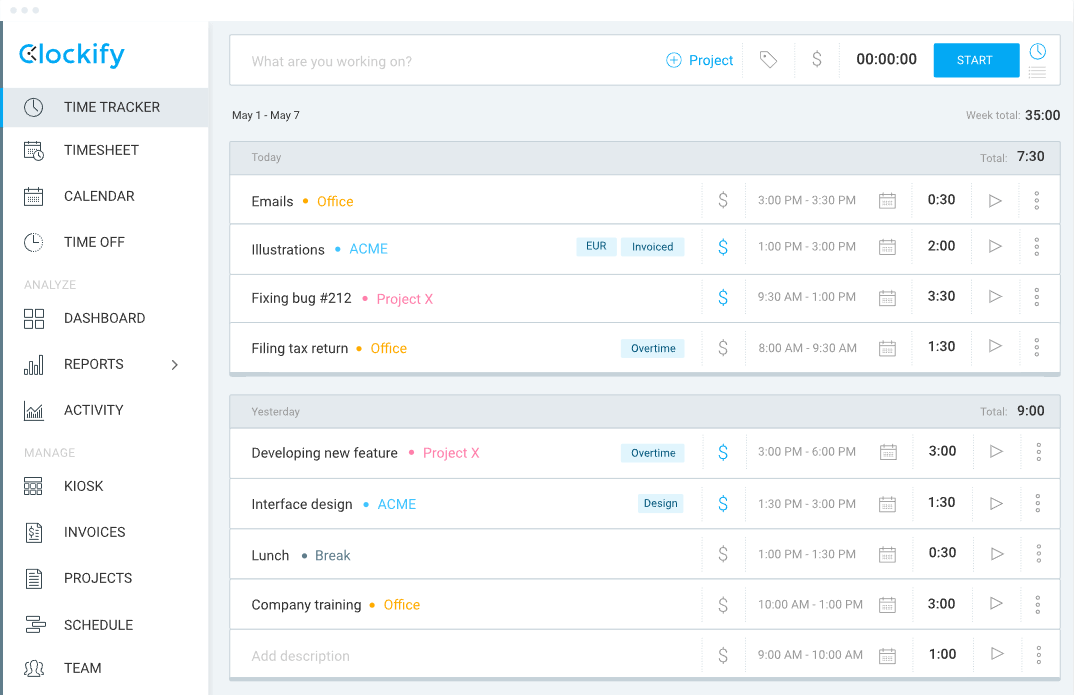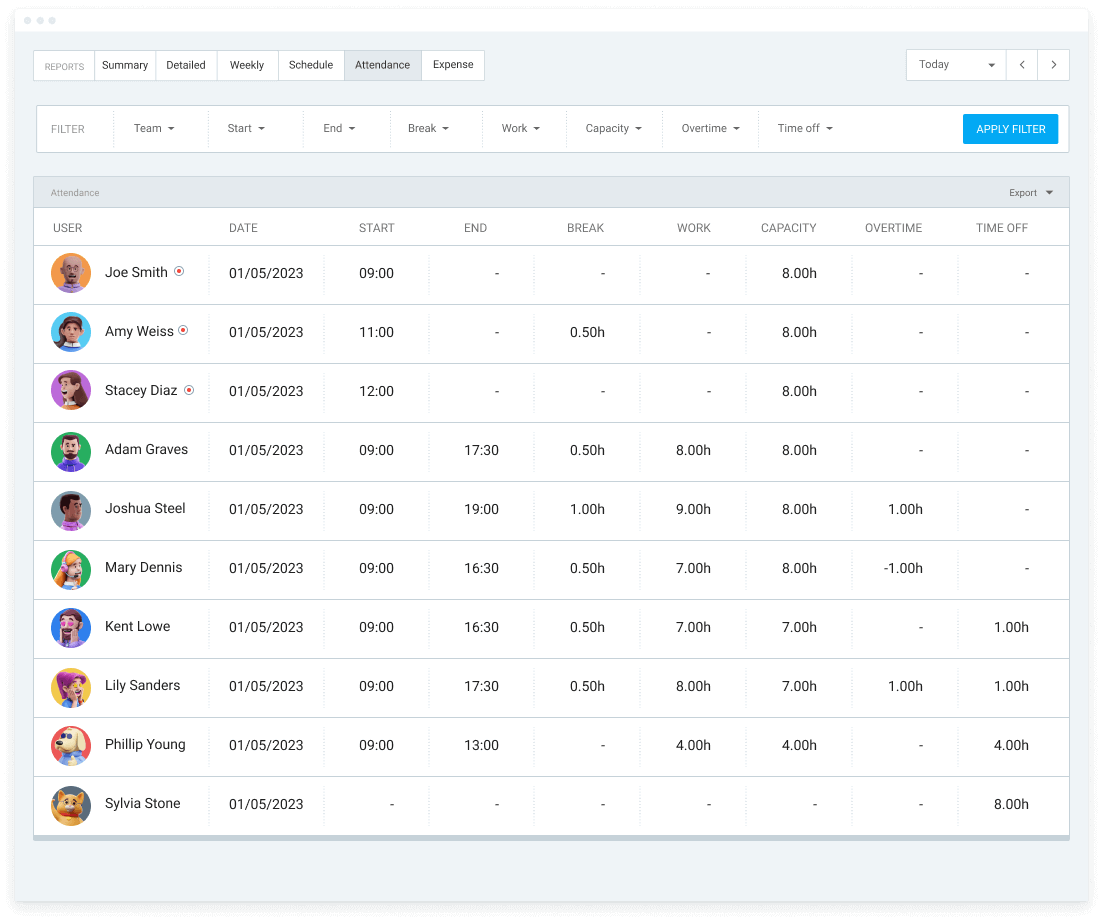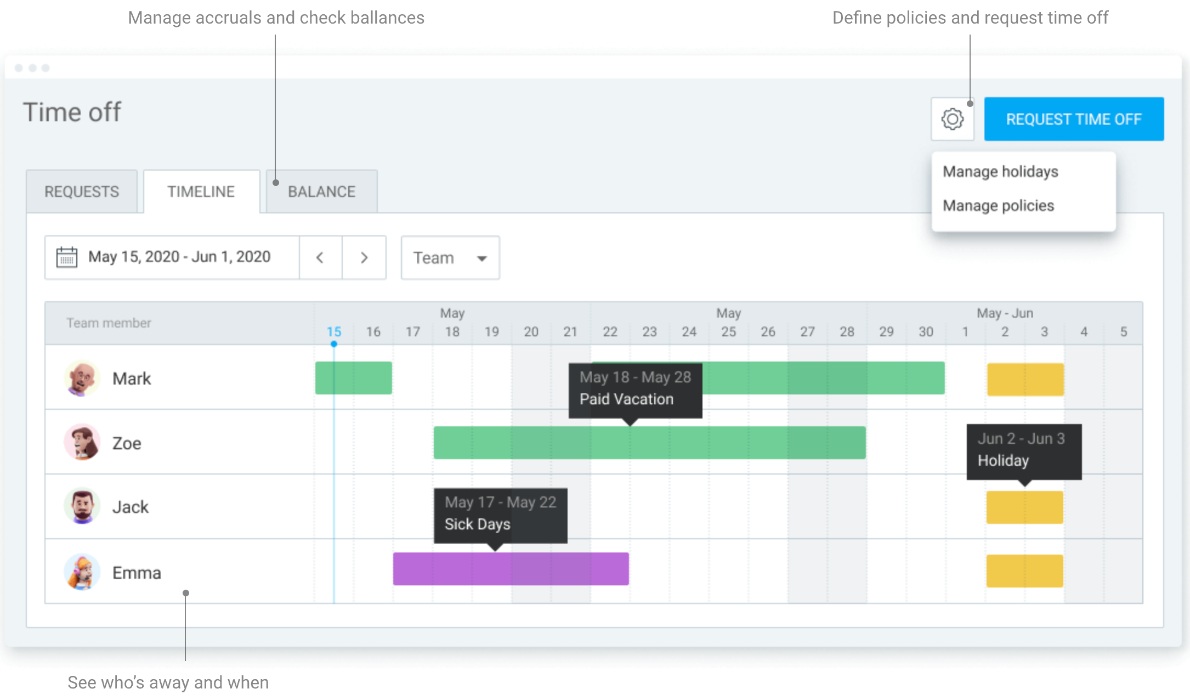Ever since we were little kids, we were taught never to be late and to always be prepared. Some can even still hear the parental echoes bouncing in their ears — Are you ready for school?!
Still, there are many factors that determine why someone is late or a no-show, especially in the work environment. Illnesses, commute, or personal issues are some of the leading factors of tardiness that we all go through from time to time.
Nowadays, many employers are quite tolerant to a certain point, but where do they draw the line? Well, the answer lies in employee attendance policies.
In the following paragraphs, we will:
- Go over the main points of all employee attendance policies,
- Offer free policy templates,
- Provide examples of how to fill them out,
- Give you tips from professionals regarding attendance policies, and
- Answer some of the most frequent questions about employee attendance policies.

What is an attendance policy?
In case you haven’t heard of an attendance policy before or your company simply does not use one, here’s a simple breakdown.
An attendance policy represents a document or a set of documents that establish clear guidelines on employee attendance for a specific business. Such documents ensure all employees are aware of rules and guidelines regarding matters such as:
- Shifts,
- Lunch breaks,
- Tardiness,
- Procedures (PTO, leaves, etc.), and
- Any disciplinary actions arising from disobeying the rules.
Not all policies are the same, and it’s up to the employer to customize them to their needs.
In line with that, the number of conditions and the exact information provided in such policies is up to the employer.
💡 Clockify Pro Tip
If you’re looking for a time attendance software which employees can use to track and better manage their work hours, take a look at the following link:
What is a good attendance policy?
A universally “good” attendance policy can not truly be crafted since there is no one-size-fits-all foundation upon which rules can be defined.
In simple terms, businesses differ and so do their requirements. Therefore, a good attendance policy is the one that suits a business the best.
Here’s a breakdown of everything your attendance policy should help you with if you want to craft the best possible one for your business.
A great attendance policy helps balance your needs and employees’
A 9-5 shift has been a standard in the business sphere for some time now, and many can not imagine working other shifts and restructuring their schedules.
However, based on the type of business and the work each employee performs, changes can disrupt a natural work-life balance.
For example, working night shifts affects the employee’s personal family time and disrupts their sleep schedule. Therefore, a good policy could include a clause stating that every employee should work no more than X night shifts a month/week in order to satisfy everyone’s needs.
A great attendance policy helps you track work hours
Outdated systems for tracking work hours have always had flaws in their way of operating — attendance sheets would get lost or someone would forget to clock in/out.
Nowadays, everyone uses a time tracker and there’s no need to employ additional manpower to oversee attendance. Therefore, setting a policy for using a time tracker would prove beneficial for both employees and the business since it would minimize errors and allow everyone to focus on their work assignments.
Time tracking systems such as Clockify automate the process to the point where clocking in/out is done with a simple login and two clicks — starting your shift and calling it a day.

A great attendance policy clarifies guidelines that support employees’ rights
Setting clear guidelines will help everyone follow the rules and not mess up in the process. However, it’s important to know where to draw the line. In other words, make your policy points reasonable.
For example, if the work hours span in the range from 9 a.m. to 6 p.m., give your employees reasonable time to take lunch breaks at appropriate times, for example — 12 p.m. and 3 p.m.
Also, if physical presence is necessary, a flexible work schedule for your employees would most surely benefit everyone since it would give them enough time to get to work without sacrificing too much of their personal time before or after shifts.
What to include in an attendance policy?
Now that you’ve gotten acquainted with the general notion of attendance policies and their purpose, we’ll list and explain some general sets of policies and points that every business should include in their customized attendance policy.
General policies
As mentioned earlier, there are some general policies that almost every business includes in their set of attendance policies, and so should you.
Such policies usually refer to:
- Working hours (daily and weekly), and
- Arrival/departure from work (office or remote).
Some businesses include a general policy for requesting time off, or have a specific policy that goes in-depth regarding the conditions and the way of using accrued time off.
💡 Clockify Pro Tip
If PTO requests give you headaches, here are some of the best templates you can use to craft your own PTO policy:
Tardiness
Almost every business clearly states specific guidelines for tardiness in their attendance sheets.
In general, tardiness is defined as being late to work, no matter the exact minutes or seconds. Still, it’s only natural that people are late due to a number of factors, which is why companies often offer a grace period — a 15-20 minute window is usually allowed.
Again, the grace period depends on the type of work your employees perform. If the task at question is time delicate, tardiness might not be tolerated. This is why most employers set guidelines that clearly state:
- The grace period,
- Time frame to notify your supervisor, and
- Disciplinary actions for tardiness.
Paid Time Off (PTO) and excused absences
Employees should have a right to PTO (paid or unpaid depending on where they live) and the number of days used usually depends on the agreement they made with the employer, but you’ll likely find that there is a state/country minimum for the number of days you can use.
However, there are certain regulations that have to be followed in order to ensure that the business will run smoothly while you’re on vacation.
Furthermore, such policy provisions should include that employees have to:
- Notify their supervisor in advance, and
- Make sure that most of their coworkers haven’t planned their vacations in the same timeframe.
Furthermore, every employer has to take into account unforeseen circumstances, such as:
- Illnesses,
- Childbirth,
- Accidents, and
- Various emergency situations.
In such cases, the policy will most definitely state that you have to notify your superior in the shortest time frame and provide the necessary information and documentation to confirm the reason for absenteeism.
Unexcused absences
Naturally, the employer has to protect themselves in cases of unexcused tardiness or absenteeism.
We can differentiate between two types of unexcused absences:
- No call no show cases, and
- Job abandonment.
No call no show
No call no show practically speaks for itself — an employee fails to appear at the place of employment or clock in if the work is performed remotely without any prior notification. The employer is to set a policy in such cases — whether no call no show can be tolerated, how many times it can happen, and the criteria for determining whether the transgression is a case of no call no show.
In some cases of emergency, it is possible that the employee wasn’t able to notify their supervisor and, therefore, could suffer disciplinary actions even though the issue in question could have excused him. Therefore, it’s important to clearly define the parameters of what no call no show is and list out the potential cases that could fall under this category.
Job abandonment
A more severe transgression is job abandonment — failure to appear at the place of employment or clock in remotely for several days without any prior notification. Again, it is up to the employer to define how many absent days are considered job abandonment.
Disciplinary actions
In case of violating and not properly adhering to any of the policies above, the employer is free to exercise any disciplinary actions that fit the criteria. The severity of the transgression will usually determine the type of disciplinary action, such as:
- First-offender warning from the direct supervisor,
- Written warning from the manager,
- Last warning — meeting with the HR department, and
- Termination.
However, all disciplinary actions have to be clearly stated in the attendance policy in order for them to be valid.
Exceptions
It is up to the employer and the legal team to come up with proper exceptions to disciplinary actions in accordance with the law. In many cases, an employee could be absent from work and be exempted due to legal or state requirements, such as:
- Jury duty,
- Military duty,
- Family and Medical Leave Act — FMLA leave,
- Voting leave,
- Emergency response leave, etc.
Employee attendance policy template
The following is a sample employee attendance policy that you can download and use to craft your own guidelines.
To download the copy of the Employee Attendance Policy (FREE TEMPLATE), click on the link leading to this format, and you’ll see a new tab popping up with the following question:
Would you like to make a copy of Employee Attendance Policy Template?
Click on the Make a copy button, and this will let you copy and edit the template. Once the copy is saved to your Drive, you’ll be able to edit and customize it to your needs.
⬇️ Employee Attendance Policy (FREE TEMPLATE)
How to fill out the attendance policy template?
Next up, we’ll fill out the template to give you a better idea of how the final product should look like. Bear in mind that the information in the example is fictitious and does not reflect real company attendance policies.
An example of Employee Attendance Policy (Template) introductory part
An introductory part to an attendance policy is important to set the tone of the document and make sure your employees know what to expect. Here’s an example you can use:
Compromising and finding a middle ground at WHMOF is the key to ensuring absolute professionalism and reaching our goals. Therefore, the following policies represent our expectations from each and every employee. It is important to note that by agreeing and signing this document, you adhere to all of the stipulations provided and are obliged to comply in order to avoid disciplinary actions.
An example of working hours policy
Here’s an example of the working hours policy that you can use for your business:
Working hours:
- All employees are expected to work from 9 a.m. to 5 p.m.,
- All employees are entitled to a lunch break lasting 30 minutes. Unless the job title requires you to work through your lunch break, you are free to take your lunch break anywhere between 12 p.m. and 3 p.m.,
- If physical presence is required, employees must be at the office no sooner than 8:30 a.m. and no later than 9 a.m.
An example of tardiness policy
Tardiness policy is the most crucial segment to include in your employee attendance policy. Here’s how you can craft your own:
Tardiness is defined as the quality of being late or slow. In other words, all employees must arrive to work on time in order to avoid disciplinary actions. However, a grace period of 30 minutes is provided in case of emergencies and excused absences.
An example of Paid Time Off (PTO) and excused absences policy
If your company offers PTO, here’s an example of a policy you can use for your business:
All employees have the right to take paid time off (PTO) at any point of the year. However, in order to avoid disciplinary actions, every employee has to:
- Check with their coworkers if they planned a vacation in the same time frame, and
- Notify their superior 2 weeks in advance.
Similarly, absenteeism is tolerated in the following cases:
- Illnesses,
- Childbirth,
- Accidents, and
- Various emergency situations which are stated clearly in the work contract.
Depending on the severity of the case, the grace period for notifying the superior is alterable, but it must be no later than 3 hours after the shift starts.
An example of unexcused absences policy
The following is an example of a policy that you can set for unexcused absences:
The unexcused absences policy recognizes two types of absences:
- No show no call
- Job abandonment
In case of no show no call — a failure to appear at the place of work without notifying the superior — the employee will receive a first-offender warning.
In case of repeated absences — 3 consecutive days or 5 times in a month — with no previous notification, the employee falls under the job abandonment category and will receive a last warning.
An example of disciplinary actions policy
Naturally, not following the guidelines will result in disciplinary actions. Here are some of the sanctions that your business can use or customize:
As stated above, not following the rules will result in disciplinary actions determining the employee’s status at the company. WHMOF recognizes the following disciplinary actions:
- First-offender warning from the direct supervisor,
- Written warning from the manager,
- Last warning — meeting with the HR department, and
- Termination.
An example of exceptions
Exceptions to the rules are quite common in any legal documents. Some of the most common exceptions in the US are listed below:
The WHMOF recognizes the following as exemptions from unexcused absenteeism:
- Jury duty,
- Military duty,
- FMLA leave,
- Voting leave, and
- Emergency response leave.
Depending on the severity of the case, the grace period for notifying the superior is alterable, but it must be no later than 5 hours after the shift starts.
I hereby accept the terms and conditions of the Employee Attendance Policies and confirm that I have read and understood the disciplinary actions that could ensue in case of failing to comply with the said Policies.
How do you improve an attendance policy?
The template and the examples we provided are by no means a definitive answer to a perfect attendance policy, but they should be able to give you a general idea on how to craft your own.
Then again, the policies themselves always rely on the needs of the business, which is why there will never be a universal attendance policy.
However, there are a couple of things to look out for when crafting your own document.
Tip #1: Always be specific
Make sure there is no wiggle room that the employees can take advantage of. For example, if the policy states that tardiness will always be tolerated for up to 15 minutes, employees will take notice and will always start their shift at 9:15 a.m (if their shift starts at 9 a.m.).
Therefore, state the number of times an employee can be tardy in a week/month’s period.
Tip #2: Be just and fair
No one wants to tolerate harsh working conditions. Still, it’s understandable if you have strict policies that are closely connected to the business’ prosperity. Therefore, make compromises and make sure everyone’s content.
For example, if it’s crucial that all employees are at the site no later than 9 a.m. and no tardiness is allowed, compensate by giving them a long lunch break or extra vacation days.
Tip #3: Make sure everyone understands the policies
It’s not ludicrous to claim that most of us, including employees and employers, skip reading documents and simply sign them. Also, the legal jargon might be tough for some and require additional explaining.
Therefore, make sure that you or your HR department goes over the employee attendance policy points with all employees so that everyone can be on board and focus on their tasks.
Tip #4: Reward compliance
There will surely be employees that have followed every policy, guidelines, and rule in the book. Therefore, it would be unfair not to reward them for their hard work and dedication.
Also, the rewards reaped from a perfect attendance record could serve as a motivation for other employees and help improve their productivity as well.
Frequently Asked Questions about employee attendance policies
If some of the previously mentioned terms were a tad confusing, the FAQ section should clear everything up.
What is a standard attendance policy?
In simple terms, a standard attendance policy represents a set of documents that regulate employee conduct when it comes to attendance. The policy, as the one detailed above, usually includes details regarding:
- Work shifts,
- Tardiness,
- PTO, and
- Other attendance-related matters.
What is a reasonable attendance policy?
A reasonable attendance policy is the one that suits both the employees and the employer. In other words, employees have enough leeway to balance out their personal and professional lives, while employers get to see perfect attendance and results.
What is a rolling 6-month attendance policy?
A rolling 6-month period is usually defined as the period from the previous 6 months that are used as a basis to calculate a certain occurrence — in this case, attendance.
Generally, companies and businesses that operate on such a basis also use an attendance point system to reward good attendance and “punish” tardiness. After 6 months, however, all attendance points and data is erased and employees can start fresh.
What is a no-fault attendance policy?
A no-fault attendance system is something we’re all familiar with from early school days. A point system assigns points for tardiness and absenteeism, and if you collect enough of them, disciplinary action ensues.
What is an attendance record?
An attendance record is used to collect and save each employee’s attendance info to compile a complete picture of the said employee’s performance.
Such documents usually include:
- Clock in/out records,
- Total hours worked in a month/year,
- Breaks taken in a month/year,
- Sick days taken in a month/year, and
- Leave used in a month/year.
Build an attendance tracking system with Clockify
An integral part of your attendance policy is an attendance tracking system that allows you to track employee work hours, PTO, breaks, and more.
To create an attendance-tracking system, you can find many apps that can make this process easier and time-saving.
That’s why you should check out Clockify.
Clockify is a free employee attendance tracker with everything you need to build a system. With its rich Attendance feature, Clockify gives you an overview of everything you need to know.
From the Report section, click on the Attendance tab. In the Attendance tab, you can see when employees start and end their work days. Also, you can view additional information such as:
- Breaks,
- Total work capacity,
- Time off, and
- Overtime hours.

Clockify also has a Time off feature where you can track your team’s holidays and time off requests. When you click on the Timeline tab, you can see who took sick leave, paid vacation, or a holiday — and when. This information helps you craft better work schedules and optimal workflows.

A good attendance policy starts with a trustworthy attendance tracking system.



